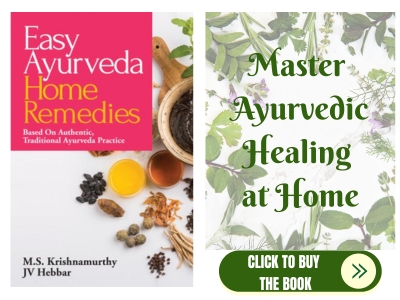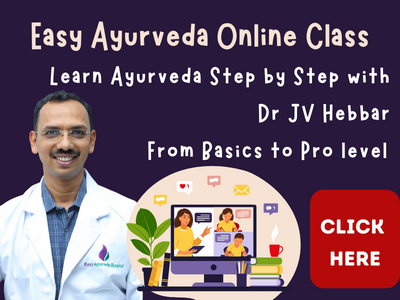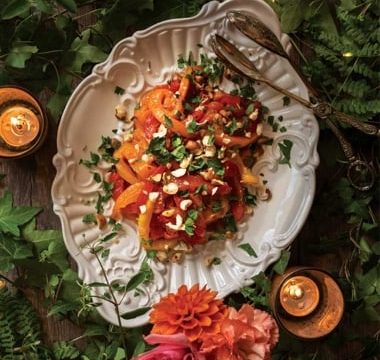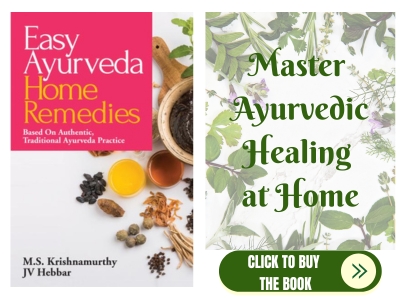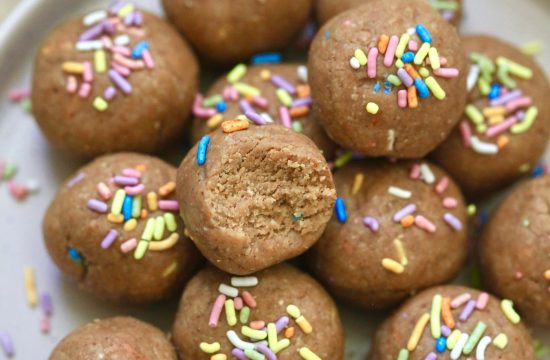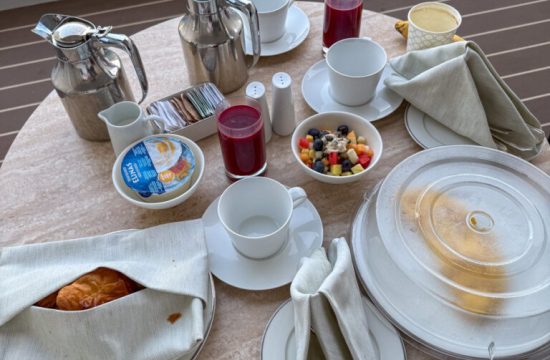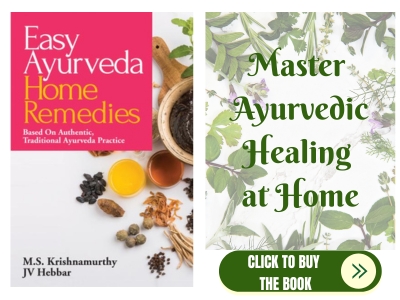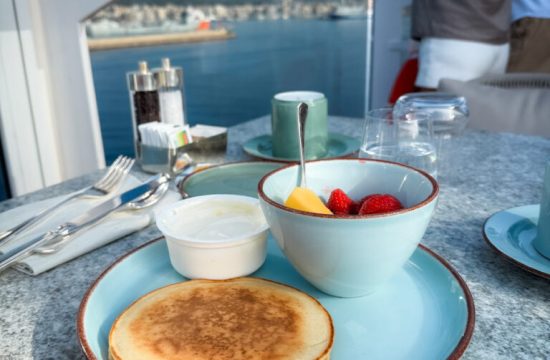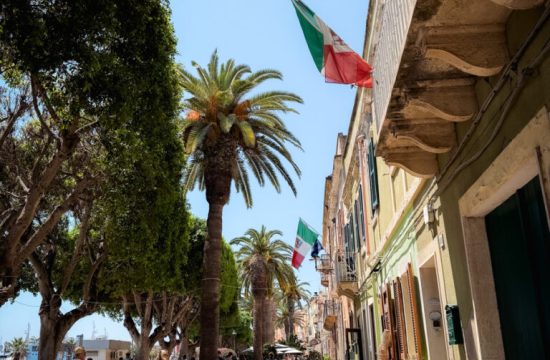The 14th chapter of Chikitsasthana of Sushruta Samhita is named as Udara Cikitsitam Adhyaya. This chapter deals with Enlargement of the abdomen.
अथातउदराणांचिकित्सतंव्याख्यास्यामः।।१।।
यथोवाचभगवान्धन्वन्तरिः।।२।।
We will now expound the Udara chikitsa- treatment of abdominal enlargements as revealed by the venerable Dhañvañtari.
Sadhyāsādhyata – prognosis
अष्टावुदराणिपूर्वमुद्दिष्टानि।तेष्वसाध्यंबद्धगुदंपरिस्राविच.अवशिष्टानिकृच्छ्रसाध्यानि.सर्वाण्येवप्रत्याख्यायोपक्रमेत।तेष्वाद्यश्चतुर्वर्गोभेषजसाध्यः,उत्तरःशस्त्रसाध्यः,कालप्रकर्षात्सर्वाण्येवशस्त्रसाध्यानिवर्जयितव्यानिवा।।३।।
Earlier i.e. in Nidana Sthana section, chapter 7, eight kinds of Udara Roga have been described. Among these eight kinds, Baddhaguda Udara and Parisrāvi Udara are incurable. The remaining six types of Udara are curable with difficulty.
The physician should treat all types of Udara after intimating about their incurability (prognosis) to the patient (and his attendants / family).
The first four types of Udara i.e. Vataja Udara, Pittaja Udara, Kaphaja Udara and Dusivisaja Udara can be treated with medicines.
The other four types of Udara are treatable with surgical therapies.
All kinds of Udara become treatable by surgery or fit to be refused (treatment shall be refused due to its bad prognosis) with lapse of time i.e. if not treated at proper time.
Pathyāpathya – suitable and unsuitable things in Udara
उदरीतुगुर्वभिष्यन्दिरूक्षविदाहिस्निग्धपिशितपरिषेकावगाहान्परिहरेत.शालिषष्टिकयवगोधूमनीवारान्नित्यमश्नीयात्।।४।।
Below mentioned should be avoided by the patients suffering from Udara i.e. abdominal enlargement –
– foods which are heavy i.e. hard to digest,
– foods which cause moisture inside the tissues,
– foods which cause dryness in the body,
– foods which produce burning sensation during digestion and
– meats rich in fat and
– taking shower / bath or immersing in water
The patient should take the below mentioned things daily –
– sāli,
– șașţika,
– yava,
– godhūma and
– nīvāra
Vātodara Cikitsā
तत्रवातोदरिणंविदारिगन्धादिसिद्धेनसर्पिषास्नेहयित्वा,तिल्वकविपक्वेनानुलोम्य,चित्राफलतैलप्रगाढेनविदारिगन्धादिकषायेणास्थापयेदनुवासयेच्च,साल्वणेनचोपनाहयेदुदरं,भोजयेच्चैनंविदारिगन्धादिसिद्धेनक्षीरेणजाङ्गलरसेनच,स्वेदयेच्चाभीक्ष्णम्।।५।।
Below mentioned treatments should be considered and done to the patient of Vatodara –
– Oleation – with ghee prepared from herbs belonging to Vidārigañdhadi Gaņa,
– Purgation – with ghee processed with Tilvaka,
– Enema – in the form of decoction enema and oil enema using the decoction of herbs belonging to Vidārigañdhādi Gana after adding more quantity of Citraphala (Dantiphala) oil
– Poultice fomentation – The abdomen of the patient of Vataja Udara should be given fomentation / poultice following Salvana Upanaha method
– Diet – Foods processed with herbs belonging to Vidārigañdhādi Gaña should be administered to the vataja udara patient along with milk, soup of meat of animals living in arid regions
– Sudation – The Vataja Udara patient should be made to sweat profusely.
Pittodara Cikitsā
पित्तॊदरिणंतुमधुरगणविपक्वेनसर्पिषास्नेहयित्वा,श्यामात्रिफलानिवृद्वि-
पक्वेनानुलोम्य,शर्करामधुघृतप्रगाढेनन्यग्रोधादिकषायेणास्थापयेदनुवासयेच्च,पायसेनोपनाहगेदुदरं,भोजयेच्चैनंविदारिगन्धादिसिद्धेनपयसा।।६।।
Below mentioned treatments should be considered and done to the patient of Pittodara –
Oleation – should be given using medicated ghee prepared from herbs belonging to Madhura Gaña (kākolyādi gaņa),
Purgation – should be administered using ghee boiled and prepared with śyāmā, triphalā and trivrt,
Enema – Medicated enema in the form of decoction enema and oil enema should be given with decoction prepared from herbs belonging to Nyagrodhadi Gana. It shall be given after adding and mixing thoroughly more quantities of sugar, honey and ghee.
Fomentation / Poultice – to the abdomen region should be done using Payasa – milk pudding.
Diet – The patient should eat food along with milk boiled with herbs belonging to Vidārigañdhadi Gana.
Kaphodara Cikitsā
श्लेष्मोदरिणंतुपिप्पल्यादिकषायसिद्धेनसर्पिषोपस्नेह्य,स्नुहीक्षीरविपक्वेनानुलोम्य,त्रिकटुकमूत्रक्षारतैलप्रगाढेनमुष्ककादिकषायेणास्थापयेदनुवासयेच्च,शणातसीधातकीकिण्वसर्षपमूलकबीजकल्कैश्चोपनाहयेदुदरं,भोजयेच्चैनंत्रिकटुकप्रगाढेनकुलत्थयूषेणपायसेनवा,स्वेदयेच्चाभीक्ष्णम्।।७।।
Below mentioned treatments should be considered and done to the patient of Slesmodara –
– Oleation – should be given to the patient suffering from Kaphaja or Slesma Udara using ghee processed with decoction of herbs belonging to Pippalyādi Gana
– Purgation – should be given using purgative boiled with Snuhi Ksira
– Enema – Medicated enema in the form of decoction enema and oil enema should be given with decoction of herbs belonging to Muskakādi Gana after having added more quantity of Trikatu, Gomutra, Yava Ksara and Taila
– Fomentation / poultice – should be given to the abdomen of the patient with poultice made from Sana, Atasi, Dhataki, Kinva, Sarsapa and seeds of Mulaka.
– Diet – The patient should take food along with Kulattha (horse gram) soup or Payasa (milk pudding) adding more quantity of Trikatu.
– Swedana – The patient of Slesmodara should be made to perspire constantly.
Düşyodara Cikitsā
दूष्योदरिणंतुप्रत्याख्यायसप्तलाशङ्खिनीस्वरससिद्धेनसर्पिषाविरेचयेन्मासमर्थमासंवा,महावृक्षक्षीरसुरागोमूत्रसिद्धेनवा.शुद्धकोष्ठंतुमद्येनाश्वमारकगुञ्जाकाकादनीमूलकल्कपाययेत्.इक्षुकाण्डानिवाकृष्णसर्पणदंशयित्वाभक्षयेद्वल्लीफलानिवा,मूलजंकन्दजंवाविषमासेवयेत्तेनागदोभवत्यन्यंवाभावमापद्यते।।८।।
Below mentioned treatments should be considered and done to the patient of Dusyodara –
The patient of Dusyodara should be treated only after being informed about the incurable nature of the disease and having taken his consent.
Purgation – The patient of Dusyodara should be given purgation daily for a month or a fortnight time. For this purpose, ghee boiled with fresh juice of Saptala and Sankhini should be used. Alternatively, ghee boiled with sap of Mahāvrkșa (snuhī), Surā (beer) and Gomūtra.
Drink – Once the abdomen of the patient is cleansed by administering purgation as explained above, he should be given wine mixed with paste of Aśvamāra, Guñja and Kākādanīmūla to drink.
Administering poison – A piece of sugarcane or a Valliphala – i.e. gourds like cucumber, melon, snake gourd etc. should be taken. These gourds should be bitten by a black serpent. This gourd should now be given to the patient for eating. Alternatively, a root or stem of poisonous plants may be given for eating. This treatment is called Visa Prayoga i.e. administering poisons. It acts as an anti-poisonous recipe or may also give the other kind of result i.e. death.
भवतिचात्र
One verse here
कुपितानिलमूलत्वात्संचितत्वान्मलस्यच।।
सर्वोदरेषुशंसन्तिबहुशस्त्वनुलोमनम्।।९।।
In the treatment of Udara Roga, experienced physicians praise the benefits of administering more of purgative therapy since the disease is caused by Vata and by accumulation of malas (doshas) in the body (which need to be flushed out by administering virechana – purgation).
Sāmanya yoga – common recipes
अतऊर्ध्वंसामान्ययोगान्वक्ष्यामः।तद्यथा-एरण्डतैलमहरहर्मासंद्वौवा केवलंमूत्रयुक्तंक्षीरयुक्तंवासेवेतोदकवर्जी,माहिषंवामूत्रंक्षीरेणनिराहारःसप्तरात्रम्,उष्ट्रीक्षीराहारोवाऽन्नवारिवर्जीपक्षं,पिप्पलीवामासंपूर्वोक्तेनविधानेनासेवेत,सैन्धवाजमोदायुक्तंवानिकुम्भतैलम्,आर्द्रश्शृङ्गवेररसपात्रशतसिद्धंवावातशूलेऽवचार्य,शृङ्गवेररसविपक्वंक्षीरमासेवेत,चव्यशृङ्गवेरकल्कंवापयसासरलदेवदारुचित्रकमेववा,मुरङ्गीशालपर्णीश्यामापुनर्नवाकल्कंवाज्योतिष्कफलतैलंवाक्षीरेणस्वर्जिकाहिङ्गमिश्रंपिबेत्,गुडद्वितीयांवाहरीतकीभक्षयेत्,स्नुहीक्षीरभावितानांवापिप्पलीनांसहस्रंकालेन,पथ्याकृष्णाचूर्णंवास्नुहीक्षीरभावितमुत्कारिकांपक्वांदापयेत्हरीतकीचूर्णंप्रस्थमाढकेघृतस्यावाप्याङ्गारेष्वभिविलाप्यखजेनाभिमथ्यानुगुप्तंकृत्वाऽर्धमासंयवपल्लेवासयेत्,ततश्चोद्धृत्यपरिस्राव्यहरीतकीक्वाथाम्लदधीन्यावाप्यविपचेत्,तद्यथायोगंमासमर्धमासंवापाययेत्.गव्येपयसिमहावृक्षक्षीरमावाप्यविपचेत्,विपक्वंचावतार्यशीतीभूतमन्थानेनाभिमथ्यनवनीतमादायभूयोमहावृक्षक्षीरेणैवविपचेत्,तद्यथायोगंमासंमासार्धंवापाययेत्चव्यचित्रकदन्त्यतिविषाकुष्ठसारिवात्रिफलाजमोदहरिद्राशङ्गिनीत्रिवृत्रिकदुकानामर्धकार्षिकाभागा,राजवृक्षफलमज्झामष्टौकर्षाः,महावृक्षक्षीरपलेद्वे,गवांक्षीरमूत्रयोरष्टावष्टौपलानि,एतत्सर्वंघृतप्रस्थेसमावाप्यविपचेत्,तद्यथायोगंमासमर्धमासंवापाययेत्।एतानितिल्वकघृतचतुर्थानिसीष्युदरगुल्मविद्रध्यष्ठीलानाहकुष्ठोन्मादापस्मारेषूपयोज्यानिविरेचनार्थं.मूत्रासवारिष्टसुराश्चाभीक्ष्णंमहावृक्षक्षीरसंभृताःसेवेत.विरेचनद्रव्यकषायंवाशृङ्गवेरदेवदारुप्रगाढम्।।१०।।
Further, some common recipes for all kinds of udara – abdominal enlargements shall be described, as enlisted below –
Eranda Taila i.e. castor oil should be administered for oral consumption mixed with Gomutra – urine of cow or milk. This recipe should be consumed by the patient every day for a period of one or two months. While taking this recipe, one should avoid drinking water.
The patient should consume buffalo urine mixed with milk for a period of seven days. He should not take any other food during this period. Alternatively he should consume only camel’s milk as food while avoiding other kinds of foods and water for a period of fortnight.
He should consume Pippali – Piper longum following the method of consuming Vardhamana Pippali previously explained in chapter 5, for a period of one month.
He should consume Nikumba Taila i.e. oil of Danti added with Saindhava and Ajamoda. Alternatively, Nikumbha Taila processed with three hundred patra (adhaka – 2.5 kg) of Srngavera juice should be consumed.
Alternatively the below mentioned recipes should be given –
– Milk boiled with juice of Srngavera or
– Paste of Cavya and Srngavera mixed with milk or
– Paste of Sarala, Devadaru and Citraka with milk or
– Paste of Murangi, Salaparni, Syama and Punarnava with milk or
– Oil of Jyotismati with milk, added with Svarjika and Hingu or
– Haritaki – Terminalia chebula added and mixed with two parts of Guda – jaggery
The patient should consume one thousand Pippali – Piper longum soaked in Snuhi Ksira as a course in stipulated time period, as much as possible (Vardhamana Pippali).
Utkarika – pan cake prepared by cooking powder of Pathya and Krsna (Pippali) soaked in milky sap of Snuhi should be consumed.
One prastha quantity (640 grams) of Haritaki – Terminalia chebula powder is taken. This powder is cooked in one adhaka (2.56 kg) of ghee on burning coal. It is churned with a churner and put into a pot. This pot is kept hidden in a heap of Yava – barley for half a month. After one month, the pot is removed and the contents are filtered. To this, decoction of Haritaki – Terminalia chebula and sour curd is added and cooked. This recipe should be consumed for a time period of one fortnight or one month.
Firstly the milk sap is obtained from Mahavrksa (Snuhi). Milk is added to this sap and cooked. After it gets cooled, it is churned with a churner and butter is extracted from it. To this is added milky sap of Mahavrksa and cooked. Ghee is obtained from it and consumed for a time period of one month or half of a month.
Half karsa (5mg) each of the below mentioned herbs are taken –
– Cavya,
– Citarka,
– Dañtī,
– Ativişā,
– Kuştha,
– Sărivā,
– Triphalā,
– Ajamodā,
– Haridrā,
– Sankhinī,
– Trivít and
– Trikațuka
Other ingredients –
– eight karsa (80 grams) of phala majja (pulp / resin of fruit) of Rajavrksa
– two pala (80 grams) of milky sap of Mahavrksa (Snuhi),
– eight pala (320 grams) of go kshira – cow milk
– eight pala (320 grams) of gomutra – cow urine and
– one prastha (640 grams) of ghee
All the above mentioned ingredients are cooked together and medicated ghee prepared. This ghee is consumed for one month or half month in suitable doses.
For purgation, the above-mentioned recipes or the four Tilvaka Ghrta described in chapter 4 should be used. When used, they are beneficial in curing the below mentioned conditions / diseases –
– abdominal enlargement,
– abdominal tumour,
– abscess,
– enlarged prostate,
– flatulence,
– leprosy,
– insanity and
– epilepsy
Or, the below mentioned may be consumed with milky sap of Mahavrksa (Snuhi) –
– asava – fermented infusion,
– arista – fermented decoction or
– sura – beer
Or more quantity of powder of Srngavera and Devadaru should be mixed in the decoction of purgative drugs (vide chp.39 of sūtrasthāna) and consumed.
Virecana guţikal / Ānāhahara varti
वमनविरेचनशिरोविरेचनद्रव्याणांपालिकाभागाःपिप्पल्यादिवचादिहरिद्रादिपरिपठितानांचद्रव्याणांश्लक्ष्णपिष्टानांयथोक्तानांचलवणानांतत्सर्वंमूत्रगणेप्रक्षिप्यमहावृक्षक्षीरप्रस्थंचमृद्वग्निनाऽवघडयन्विपचेदप्रदग्धकल्क,तत्साधुसिद्धमत्रतार्यशीतीभूतमक्षमात्रागुटिकावर्तयेत्,तासामेकांद्वेतिस्रोवागुटिकाबलापेक्षयामासांस्त्रींश्चतुरोवासेवेत,एषाऽऽनाहवर्तिक्रियाविशेषेणमहाव्याधिषूपयुज्यते(विशेषण),कोष्ठजांश्चकृमीनपहन्तिकासश्र्वासकृमिकुष्टप्रतिश्यायारॊचकाविपाकादावर्तांश्र्चनाशयति॥११॥
Ingredients –
– one pala (40 grams) each of – herbs mentioned under vamana (emetics), virecana (purgatives), sirovirecana (head purging) group of herbs
– one pala (40 grams) each of herbs mentioned in Pippalyadi, Vacadi and Haridradi Gana
– one pala of all the lavanas (salts)
The above said ingredients are made into paste and soaked in mixture of all the mutras i.e. urines of animals mentioned in mutravarga (chapter 45 of Sutra Sthana section of the same treatise).
To this, one prastha (640 grams) of milky sap of Mahavrksa (Snuhi) is also added.
These ingredients are cooked over a mild fire. While cooking, the ingredients are stirred all the time, not allowing the paste to get charred.
Later, it is taken out of the oven. After the ingredients get cooled it is made into dragees / tablets of one aksa (10 grams) in quantity.
One, two or three numbers of these drugs / tablets are consumed keeping in view the strength of the person. It should be taken for a period of three or four months.
These tablets / dragees are specially used in treating mahāvyadhis i.e. dreadful diseases. They also destroy the intestinal worms.
They are used to cure the below mentioned diseases –
– cough,
– dyspnoea,
– worms,
– leprosy / skin diseases,
– nasal catarrh,
– anorexia,
– dyspnoea and
– upward movement of vayu (upward peristalsis)
Madanādi gudavarti – rectal suppositories
मदनफलमज्जकुटजजीमूतकेक्ष्वाकुधामार्गवत्रिवृत्रिकटुकसर्षपलवणनिमहावृक्षश्मीरमूत्रयोरन्यतरेणपिष्टवाऽङ्गुष्ठमात्रांवर्तिकृत्वोदरिणआनाहेतैललवणाभ्यक्तगुदस्यैकांद्वेनिस्न्नॊवापायौनिदध्यात्,एषाऽऽनाहवर्तिक्रियावातमूत्रपुरीषोदावर्तामानानाहेषुविधेया।।१२।।
Below mentioned ingredients are macerated in the milky sap of Mahavrksa (snuhi), mutra (urines) or any similar liquids and made into wicks of the size of the thumb –
– Madanaphala majja,
– Kutaja,
– Jimutaka,
– Iksvāku,
– Dhāmārgava,
– Trivrt,
– Trikatu,
– Sarsapa and
– Lavana (salts)
Anus is lubricated with a mixture of oil and salt. After this, one, two or three of these wicks are introduced into the rectum.
These rectal suppositories would relieve flatulence when used in patients of abdominal enlargements. Therefore they are advocated for usage in the below mentioned conditions –
– obstruction of flatus, urine and faeces,
– reverse peristalsis,
– tympanitis and
– flatulence
Plīhodara Cikitsā – treatment of splenomegaly
प्लीहोदरिणःस्निग्धस्विन्नस्यदध्नाभुक्तवतोवामबाहौकूर्पराभ्यन्तरतःसिरांविध्येत्,विमर्दयेच्चपाणिनाप्लीहानंरुधिरस्यन्दनार्थःततःसंशुद्धदेहंसमुद्रशुक्तिकाक्षारंपयसापाययेत,हिमुसौवर्चिकेवाक्षीरेण,स्रुतेनपलाशक्षारेणवायवक्षारं,किंशुकक्षारोदकेनवाबहुशःस्रुतेनयवक्षारं,पारिजातकेक्षुरकापामार्गक्षारंवा,तैलसंसृष्टंशोभाञ्जनकयूषंपिप्पलीसैन्धवचित्रकयुक्तं,पूतिकरञ्जक्षारंवाऽम्लत्रुतंबिडलवणपिप्पलीप्रगाढम्।।१३।।
In Plihodara, there is enlargement of abdomen due to enlargement of Pliha (spleen). Patients of Plihodara should be first given with oleation and sudation therapies.
Following this, he should be served with food mixed with curds (yoghurt).
After this, the physician should puncture the vein of the left arm, inside the elbow joint of the patient. At the same time, the spleen of the patient is pressed with the hand to enable more blood to flow out.
After purification, the patient should be given one of the below mentioned recipes –
– warm milk added with samudra sukti (shells of sea oysters) or
– warm milk with hingu – asafoetida and sauvarcika ksara or
– with palasa ksara or yava ksara filtered many times in the solution of ash of kimsuka or
– ash of parijata, iksuraka and apamarga or
– drinking of yusa – soup prepared from sobhanjana added with oil and powder of pippali, saindhava lavana and citraka or
– ash of putikaranja dissolved in any sour juice adding more quantity of powder of bida lavana and pippali n any sour juice adding more of powder or bida lavana and pippali.
Satpala Ghrta
पिप्पलीपिप्पलीमूलचव्यचित्रकशृङ्गवेरयवक्षारसैन्धवानांपालिकाभागाः,घृतप्रस्थंतत्तुल्यंचक्षीरंतदैकध्यंविपाचयेत्,एतत्षट्पलकंनामसर्पिःप्लीहाग्निसङ्गगुल्मोदरोदावर्तश्वयथुपाण्डुरोगकासश्वासप्रतिश्यायोर्ध्ववातविषमज्वरानपहन्ति।मन्दाग्निर्वाहिङ्ग्वादिकंचूर्णमुपयुञ्जीत।।१४।।
Ingredients –
One pala (40 grams) each of –
– Pippali,
– Pippalīmāla,
– Cavya,
– Citarka,
– Srñgavera,
– Yavakşāra and
– Saindhava
One prastha (640 gm) of – ghrta (ghee) and
Equal quantity of i.e. one prastha (640 gm) of – milk
All the above said ingredients are cooked together so as to prepare medicated ghee. This medicated ghee is known by the name Satpalaka Ghrta.
Benefits – This ghrta cures the below mentioned conditions –
– enlargement of spleen,
– weak digestive power,
– abdominal tumour,
– enlargement of abdomen,
– reverse peristalsis,
– dropsy,
– anaemia,
– cough,
– dyspnoea,
– nasal catarrh,
– excessive belching and
– intermittent fever
Hiñgvādi Cūrņa should be used by the patients who have weak digestive fire.
मणिबन्धंसकृन्नाम्यवामाङ्गुष्ठसमीरिताम्।।
दहेत्सिरांशरेणाशुप्लीह्नोवैद्यःप्रशान्तये।।१६।।
The left wrist of the patient should be bent inwards closely so as to bulge the vein. The vein coming up near the left thumb should now be burnt (cauterized) with the help of a red hot arrow or by a red hot iron rod with the intention of reducing the size of the enlarged spleen (in plihodara).
यकृहाल्येऽप्येषएवक्रियाविभागः।
विशेषतस्तुदक्षिणबाहौसिराव्यधः।।१५।।
The same treatment (as explained for Plihodara) should be done in case of Yakrddalyodara / Yakrtodara (hepatomegaly / enlargement of liver) but the vein puncture should be done on the right arm (instead of on the left).
Baddhagudodara Cikitsā – treatment of intestinal obstruction
बद्धगुदेपरिस्राविणीचस्निग्धस्विन्नस्याभ्यक्तस्याधोनामेमतश्चतुरङ्गुलमपहायरोमराज्याउदरंपाटयित्वाचतुरङ्गुलप्रमाणमन्त्राणिनिष्कृष्यनिरीक्ष्यबद्धगुदस्यान्त्रप्रतिरोधकरमश्मानंबालंवाऽपोह्यमलजातंवाततोमधुसर्पिभ्या॑मभ्यज्यान्त्राणियथास्थानंस्थापयित्वाबाह्यव्रणमुदरस्यसीव्येत्।
In Baddhagudodara, the abdomen of the patient is enlarged due to intestinal obstruction. In this condition oleation and sudation therapies should be done first. The abdomen should be anointed and then the abdomen is cut open. For this, the incision should be made below the umbilicus allowing four angula (8 cm) space from the line of hairs situated in the central line of the abdomen. After putting the incision, the intestine is gently pulled out through the wound (opening). The pulled out intestine is examined for the presence of stone, hair, faeces or any other material which is causing obstruction of the intestine. Once they are found, they should be removed. Following this, the intestine is anointed with a mixture of honey and ghee and later placed in its normal place by pushing it inside. After this, the external wound of the abdomen is sutured.
Parisrāviudara cikitsā
परित्राविण्यप्येवमेवशल्यमुद्धृत्यान्त्रनावान्संशोध्य,तच्छिद्रमान्नंसमाधायकालपिपीलिकाभिदंशयेत्,दष्टेचतासांकायानपहरेन्नशिरांसि,ततःपूर्ववत्सीव्येत्,संधानचयथोक्तंकारयेत्,यष्टीमधुकमिश्रयाचकृष्णमृदाऽवलिप्यबन्धेनोपचरेत्,ततोनिवातमागारप्रवेश्याचारिकमुपदिशेत्,वासयेच्चैनंतैलद्रोण्यांसर्पिोण्यांवापयोवृत्तिमिति।।१७।।
In Parisraviudara (abdominal enlargement due to intestinal puncture) the the Salya (foreign body causing the puncture) is removed in the same way as described above, the intestinal exudate cleaned (removed), the cut ends of intestine are brought close and got bitten by big black ants. When the ants have properly bitten the ends of the intestine their heads are chopped off from their bodies (bodies are cut off). Afterwards the abdomen should be sutured as described earlier.
A paste is prepared by mixing black mud with Yastimadhu – licorice powder. This paste should be applied on the abdomen of the patient as a plaster and then bandaged properly.
After this, the patient is made to enter a room devoid of breeze and allowed to stay there. While staying there he should be prescribed an ideal regimen of food and activities. The attendants should be explained about their duties towards the patient. The patient should be made to lie down in a bathtub filled with oil or ghee (medicated) for some days. He should sustain on milk only as food during this period.
Dakodara Cikitsā – treatment of Ascitis
दकोदरिणस्तुवातहरतैलाभ्यक्तस्योष्णोदकस्विन्नस्यस्थितस्याप्तैःसुपरिगृहीतस्याकक्षात्परिवेष्टितस्याधोनाभेर्वामतश्चतुरङ्गुलमपहायरोमराज्याव्रीहिमुखेनाङ्गुष्ठोदरप्रमाणमवगार्डविध्येत्,तत्रत्रप्वादीनामन्यतमस्यनाडीद्विद्वारांपक्षनाडीवासंयोज्यदोषोदकमवसिञ्चेत्,ततोनाडीमपहृत्यतैललवणेनाभ्यज्यव्रणंबन्धेनोपचरेत्,नचैकस्मिन्नेवदिवसेसर्वदोषोदकमपहरेत्,सहसाह्यपहृतेतृष्णाज्वराङ्गमर्दातीसारश्वासकासपाददाहाउत्पद्येरन्नापूर्यतेवाभृशतरमुदरमसञ्जातप्राणस्य,तस्मात्तृतीयचतुर्थपञ्चमषष्ठाष्टमदशमद्वादशषोडशरात्राणामन्यतममन्तरीकृत्यदोषोदकमल्पाल्पमवसिञ्चत्निःस्तेचदोषेगाढतरमाविककौशेयचर्मणामन्यतमेनपरिवेष्टयेदुदरं,तथानाध्मापयतिवायुः.षण्मासांश्चपयसाभोजयेज्जाङ्गलरसेनवा,ततस्त्रीन्मासान ? दकेनपयसाफलाम्लेनजाङ्गलरसेनवा,अवशिष्टंमासत्रयमन्नंलघुहितंवासेवेत,एवंसंवत्सरेणागदोभवति।।१८।।
The abdomen of the patient of Dakodara (ascites) should be given anointment / massage with vata mitigating oils. After this, fomentation should be given by using hot water (pads soaked in hot water or pouring hot water on the abdomen).
The patient is now made to sit on a chair or cot of the height of his knee (knee height). He should be held tight in position by his well wishers i.e. relatives or attendants, wrapped with cloth bands from armpit downwards.
Next, the abdomen of the patient should be punctured with the help of vrihimukha sastra i.e trocar, allowing a space of four angulas (8cm) from the midline of the abdomen, on the left side of the abdomen and below the umbilicus. The puncture should be done to a depth of thickness of the centre of the thumb. A tube (cannula) made of tin etc (metallic tube) or feather of birds having openings at both ends is fixed to the trocar and the vitiated fluid accumulated in the abdomen is drained out.
After draining the fluid, the tube i.e. trocar and cannula is removed. The wound is anointed with oil mixed with saindhava lavana – rock salt and is bandaged. The physician / surgeon should not remove all the vitiated fluid in a single sitting itself i.e. it should not be removed in one day itself. If the fluid is removed at once, it may give rise to thirst, fever, body-aches, diarrhoea, dyspnoea, cough and burning sensation in the soles. Also, the fluid may once again accumulate in the abdomen in excess even before the strength (of the abdomen and patient) is regained. Therefore, the vitiated fluids should be removed at intervals of three, four, five, six, eight, ten, twelve, sixteen or such other days. The fluid should be removed in less quantities.
After removing the vitiated fluids, the abdomen should be bandaged tightly using bands of wool, silk or leather such that the air does not cause abdominal bloating.
The patient shall take foods either with milk or meat soup of animals living in arid lands for a period of first six months. Foods should be taken with milk added with half its quantity of water or juice of sour fruits or meat soup of animals living in arid lands during the next three months. In the remaining three months he should consume boiled rice which is light and suitable.
In this manner, the person would get cured of ascites in one year time by adhering strictly to the regimen.
भवतिचात्र
आस्थापनेचैवविरेचनेचपानेतथाऽऽहारविधिक्रियासु।।
सर्वोदरिभ्यःकुशलैःप्रयोज्यंक्षीरंशृतंजाङ्गलजोरसोवा।।१९।।
One verse here,
In the treatment of all kinds of Udara i.e. abdominal enlargement, an intelligent and experienced physician should plan and administer the therapies like decoction enema, purgation, regimen of foods, drinks, boiled milk and meat soup.
इतिसुश्रुतसंहितायांचिकित्सास्थानेउदरचिकित्सितंनाम चतुर्दशोऽध्यायः।।१४।।
Thus ends the fourteenth chapter by name Udara cikitsita in Cikitsā Sthāna of Susruta Samhita.


